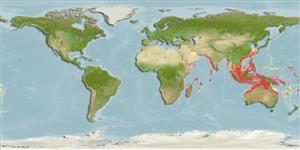分類 / Names
共通名の | 類義語 | Catalog of Fishes(部類, 種) | ITIS | CoL | WoRMS | Cloffa
板鰓亜鋼(サメとエイ類) (sharks and rays) >
Carcharhiniformes (Ground sharks) >
Carcharhinidae (Requiem sharks)
Etymology: Carcharhinus: karcharos (Gr.), sharp or jagged; rhinus, an ancient name for sharks, from rhine (Gr.), rasp, both words alluding to a shark's jagged, rasp-like skin. (See ETYFish); sorrah: Tamil (Indian subcontinent) word for shark [authorship often attributed to Müller & Henle, who published Valenciennes’ description]. (See ETYFish).
Environment: milieu / climate zone / depth range / distribution range
生態学
海; 汽水性の 関連する礁; 深さの範囲 0 - 140 m (Ref. 30573), usually 1 - 73 m (Ref. 90102). Tropical; 31°N - 31°S
Indo-West Pacific: Persian Gulf (Ref. 68964), Red Sea and East Africa (including Madagascar, Mauritius and Seychelles) to the Philippines, north to China, south to Australia. Also from Vanikolo Island (Santa Cruz Islands) and the Solomon Islands. Possibly occurring in the Gulf of Aden, Gulf of Oman and Sri Lanka (Ref. 9997).
Length at first maturity / サイズ / 重さ / 年齢
Maturity: Lm 130.0 range ? - ? cm
Max length : 160 cm TL オス/雌雄の選別がない; (Ref. 2334); 最大公表体重: 28.0 kg (Ref. 6390); 最大記録サイズ: 8 年 (Ref. 6390)
背面の脊椎 (合計): 0; 背鰭 (合計): 0; 肛門の骨 0; 臀鰭: 0. A small, spindle-shaped shark with a long, rounded snout, large circular eyes, and oblique-cusped serrated teeth; 2nd dorsal fin very low; interdorsal ridge present (Ref. 5578). 2nd dorsal, pectorals and lower caudal lobe with dark tips; 1st dorsal with thin but conspicuous dark tip; pelvic fins and upper caudal lobe plain (Ref. 5485). Grey or grey-brown above, white below with a golden-brown sheen on the area between eyes and gill slits (in fresh specimens); pectorals, second dorsal, and lower caudal fin lobe with conspicuous black tips, first dorsal and upper caudal fin lobe with black edging (Ref. 9997). A dark band on flank extending rearwards to pelvic fins (Ref. 9997).
Found on the continental and insular shelves, primarily near reefs (Ref. 244). Sometimes in offshore waters (Ref. 30573). Live near the seabed during the day and near the surface at night (Ref. 6390). Feeds on bony fishes (Ref. 68964). Shark movements often short (50 km) but may be more than 1,000 km (Ref. 6390). Prefers teleost fishes but also feeds on cephalopods and crustaceans (Ref. 6871). Viviparous (Ref. 50449). Regularly caught by local artisanal and small-scale commercial fisheries where it occurs (Ref. 244). Utilized as a food fish; fins used in the oriental shark fin trade, liver for vitamin oil, and offal for fishmeal (Ref. 9997).
Life cycle and mating behavior
成熟 | 繁殖 | 放精 | 卵 | 生産力 | 幼生
Viviparous, with a yolk-sac placenta (Ref. 244). Pups, average 3, range 1-8, are produced in January after a 10-month gestation period. Average length at birth is 50 cm TL. Length increases by about 25 cm during the first year. These sharks breed once each year (Ref. 13440). Distinct pairing with embrace (Ref. 205).
Compagno, L.J.V., 1984. FAO Species Catalogue. Vol. 4. Sharks of the world. An annotated and illustrated catalogue of shark species known to date. Part 2 - Carcharhiniformes. FAO Fish. Synop. 125(4/2):251-655. Rome: FAO. (Ref. 244)
Human uses
水産業: 少数商業の
より多くの情報
参考文献水産養殖水産養殖の紹介緊張遺伝子のElectrophoreses遺伝病気行列NutrientsMass conversion
協力者画像Stamps, Coins Misc.音シガテラ(食中毒の名前)速度泳ぐ 型式カマOtoliths脳視覚
用具
特記事項
XMLをダウンロードして下さい
インターネットの情報源
Estimates based on models
Preferred temperature (Ref.
123201): 24.5 - 29, mean 27.8 °C (based on 2844 cells).
Phylogenetic diversity index (Ref.
82804): PD
50 = 0.5000 [Uniqueness, from 0.5 = low to 2.0 = high].
Bayesian length-weight: a=0.00331 (0.00184 - 0.00595), b=3.15 (3.00 - 3.30), in cm total length, based on LWR estimates for this species & Genus-body shape (Ref.
93245).
栄養段階 (Ref.
69278): 4.2 ±0.5 se; based on diet studies.
Generation time: 3.2 ( na - na) years. Estimated as median ln(3)/K based on 2
growth studies.
回復力 (Ref.
120179): 低い, 4.5年~14年の倍増期間の最小個体群 (K=0.34; tm=2-3; tmax=8; Fec=3).
Prior r = 0.28, 95% CL = 0.16 - 0.49, Based on 1 stock assessment.
Fishing Vulnerability (Ref.
59153): Moderate to high vulnerability (50 of 100).
Climate Vulnerability (Ref.
125649): Very high vulnerability (90 of 100).
Nutrients (Ref.
124155): Calcium = 8.62 [1.61, 44.76] mg/100g; Iron = 0.433 [0.105, 1.215] mg/100g; Protein = 22.5 [19.7, 24.7] %; Omega3 = 0.127 [0.051, 0.297] g/100g; Selenium = 32.8 [8.5, 90.3] μg/100g; VitaminA = 44.4 [14.6, 133.4] μg/100g; Zinc = 0.637 [0.305, 1.261] mg/100g (wet weight);
